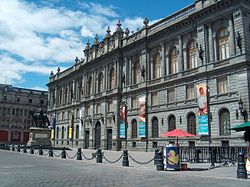MUNAL

Museo Nacional de Arte
|
|
| Location | Historical center of Mexico City |
|---|---|
| Website | http://www.munal.mx/munal/ |
The Museo Nacional de Arte (MUNAL) (English: National Museum of Art) is the Mexican national art museum, located in the historical center of Mexico City. The museum is housed in a neoclassical building at No. 8 Tacuba, Col. Centro, Mexico City. It includes a large collection representing the history of Mexican art from the mid-sixteenth century to the mid 20th century. It is recognizable by Manuel Tolsá's large equestrian statue of Charles IV of Spain, who was the monarch just before Mexico gained its independence. It was originally in the Zocalo but it was moved to several locations, not out of deference to the king but rather to conserve a piece of art, according to the plaque at the base. It arrived at its present location in 1979.
The museum was founded in 1982 as the Museo Nacional de Arte, and re-inaugurated in 2000, after reopening its doors to the public as MUNAL after intense remodeling and technical upgrades to the facility. It currently focuses on the exhibition, study and diffusion of Mexican and international art from the 16th century to the first half of the 20th century. Its permanent collection contains more than 3,000 pieces and has 5,500m2 of exhibition space. MUNAL is a subdivision of the Instituto Nacional de Bellas Artes and as part of this organization is involved in projects concerning the conservation, exhibition, and study of the fine arts of Mexico. The museum also offers workshops, colloquiums, publication and other outreaches to the public. There are also volunteer opportunities such as the Voluntariado and the Amigos de MUNAL associations.
MUNAL is located in the old Palace of Communications. In the early part of the 20th century, the government hired Italian architect Silvio Contri to design and build this “palace” to house the Secretariat of Communications and Public Works, with the intention to show Mexico's commitment to modernization. The Palace was constructed on the former site of the hospitals of San Andres and of Gonzalez Echeverria. The architectural design is eclectic, mixing elements of past architectural styles, which is characteristic of that time period. This blending would later solidify into a movement called “modernismo” both because of the tendency to use newly devised construction techniques and the tendency to use metal in the decorative aspects, to symbolize progress in the Industrial Age. The decorative elements of the building were done by the Coppedé family of Florence, who designed the door knockers, the window frames, the leaded crystal, the stonework, the furniture, lamps and ironwork among many other elements. Over the years, much of the Palace deteriorated until around 2000, when Project MUNAL restored the palace to its original look, while also adding the latest technology for the preservation of artistic works.
...
Wikipedia
